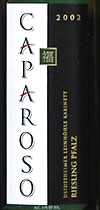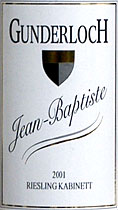|
Rediscovering Riesling On the rare occasions when I think about it at all, I wonder why wines made from the Riesling grape aren't more popular outside Germany and the few other places where the variety thrives. Riesling, after all, would seem to have all the characteristics to make it a hot seller in the American marketplace: It's light, quenching, fruity and slightly sweet ... hey! That almost sounds like a soft drink. What's more, it's usually relatively low in alcohol, making it a rational option when you want a glass for lunch. And it's one of the most compatible wines you'll find in terms of its affinity for a broad range of food. It's good with seafood, chicken, even pork; amazingly good with the vibrant flavors of Asian and Pacific Rim cuisines, and it's one of the few wines that really works with fiery fare. What's not to like? Nuthin'. And yet I'm as bad an offender as anyone: I talk a good Riesling game, but I actually buy and drink the stuff maybe a half-dozen times a year. The conventional wisdom holds that Riesling is a hard sell to people outside Germany because the labels are so difficult, and there may be some truth in that. Start with the naturally polysyllabic nature of German family names like von Bassermann-Jordan or Assmannshausen. Add tongue-twisting place names like Schlossböckelheim or Gimmeldingen, spice with some wine-law language along the lines of Gutsabfüllung ("estate-bottled") and such grape variety names as the strangling Gewürztraminer or the amusing Scheurebe, and you might as well sing "John Jacob Jingleheimer Schmidt" as try to ask for this stuff in an English-speaking wine shop. But that explanation is not entirely satisfactory, as Rieslings from German-speaking Austria and sometimes-German-speaking Alsace bear simpler labels, and those from Australia, New Zealand, the U.S. West Coast or New York's Finger Lakes and Ontario, Canada, are downright easy to pronounce. Moreover, even the Germans are starting to get the idea, as in the two German Rieslings I feature today, which limit the main label to relatively simple terms, placing the hard-to-pronounce bits in fine print on the back. My personal Riesling resistance is based more on the simple reality that Riesling is different. It takes a paradigm shift, to use a current buzzword, to move over from the familiar flavor profiles of dry French and Italian table wines and their New World descendants to the entirely different style of Riesling. But it's a jump worth making, at least for an occasional change of pace. And now's the time, with plenty of wine from the outstanding 2001 German vintage still widely available. (Vintage 2002 was more variable, as vintages from this northern-edge wine region tend to be, but there's excellent wine to be had, as demonstrated the remarkable Caparoso Riesling from the Rheinhessen that I report today.) Finally, from the standpoint of value-hunting, bear in mind that popularity and price in wine tend to be inversely proportional. Until the world discovers Riesling, it tends to be priced deliciously low. WEB LINKS: Want to read more about Riesling? Here are a couple of good articles from our archives:
• Randy Caparoso, the distributor of today's first featured wine, is a regular columnist on WineLoversPage.com. He recently filed an article celebrating Riesling in general and its food-friendliness in particular. Headlined, "Is Riesling the Greatest White Wine For Food?" it's online at
• For an excellent article explaining the German wine classification system in detail, see John Trombley's report on WineLoversPage.com, "Knowing the German Quality System for Wines," online at  Caparoso 2002 Deidesheimer Leinhöhle Pfalz Riesling Kabinett ($20)
Caparoso 2002 Deidesheimer Leinhöhle Pfalz Riesling Kabinett ($20)
Very pale straw color with a slight greenish hue, this fine Riesling blasts from the glass with remarkable fruit-bowl scents of juicy grapefruit and luscious pineapple, an aroma that demands a taste. The flavor follows through, a beautiful balance of gentle, just off-dry fruit and steely acidity, tart and quenching, with a subtle flinty minerality that adds a serious layer of complexity. This one will go a long way to recalibrate your palate if you've found Riesling boring. U.S. importer: USA Wine West, San Rafael, Calif. (Sept. 8, 2003) FOOD MATCH: Fine with alder-smoked salmon tossed with farfalle pasta and a dollop of creme fraiche lightly accented with Indian spice. VALUE: Not a low-end Riesling, but a wine of unusual balance and complexity for this price. WHEN TO DRINK: Delicious now, not really meant for aging ... but Riesling can do remarkable things with time, so don't sell its cellar potential short.
WEB LINK: Caparoso Wines' Website, with a fact sheet on all its wines and information about availability, is online at  Gunderloch 2001 "Jean-Baptiste" Rheinhessen Riesling Kabinett ($12.99)
Gunderloch 2001 "Jean-Baptiste" Rheinhessen Riesling Kabinett ($12.99)
Gunderloch uses the "Jean-Baptiste" label, an allusion to a character in the German dramatist Carl Zuckmayer's play "The Jolly Vineyard," to denote the wines it considers particularly typical of the Rhine. This one seems to fit. Very pale in color, transparent straw with a hint of brass, it offers typical Rhine Riesling aromas of musky melon with a snappy citric whiff of lime. Its soft and sippable flavor is focused on pears and apples, a hint of fresh-fruit sweetness nicely balanced by crisp acidity. U.S. importer: Rudi Wiest, Cellars International Inc., Carlsbad, Calif. (Sept. 8, 2003) FOOD MATCH: Fine with alder-smoked salmon over pasta. VALUE: Reasonably priced. WHEN TO DRINK: Although Rieslings can age gracefully, this one is delicious now.
WEB LINK: Weingut Gunderloch offers a Website in English and German. The English pages begin here: Administrivia To subscribe or unsubscribe from The 30 Second Wine Advisor, change your E-mail address, or for any other administrative matters, please use the individualized hotlink found at the end of your E-mail edition. If this is not practical, contact me by E-mail at wine@wineloverspage.com, including the exact E-mail address that you used when you subscribed, so I can find your record. We do not use our E-mail list for any other purpose and will never give or sell your name or E-mail address to anyone. I welcome feedback, suggestions, and ideas for future columns. To contact me, please send E-mail to wine@wineloverspage.com All the wine-tasting reports posted here are consumer-oriented. In order to maintain objectivity and avoid conflicts of interest, I purchase all the wines I rate at my own expense in retail stores and accept no samples, gifts or other gratuities from the wine industry.
Wednesday, Sept. 10, 2003 |




